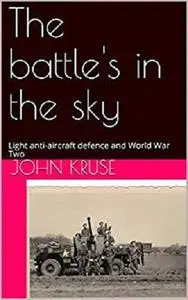The battle's in the sky: Light anti-aircraft defence and World War Two by John Kruse
English | January 14, 2019 | ASIN: B07MTPZ8MN | 202 pages | AZW3 | 1.73 MB
English | January 14, 2019 | ASIN: B07MTPZ8MN | 202 pages | AZW3 | 1.73 MB
'The battle's in the sky' explores two neglected aspects of World War II military history- the role performed by light anti-aircraft units armed with Bofors guns and the role of the Royal Electrical and Mechanical Engineers (REME) in supporting units by servicing, repairing and adapting their weapons and vehicles.
Between 1939 and 1944 light anti-aircraft (LAA) units helped defend Britain from German air attack, playing a particular role in responding to the V1 doodle-bug missiles. After the invasion of Europe in June 1944 LAA units were sent to protect the ground forces from Luftwaffe attack. As the Allies gained air superiority, though, the units' role changed and the LAA guns were converted into mobile platforms, providing intense supporting fire for troops.
The central character in this book is the author's father, Doug. He joined the army in June 1940, serving initially with RAOC and thereafter with REME. He served successively with 116 LAA and 58 LAA. The book follows his service career, which took him around the country as part of ADGB (Air defence of Great Britain) before he accompanied the advance into North Western Europe, ultimately ending up on the German island of Sylt, where his regiment dealt with PoWs and displaced Polish citizens after the war ended. On the way he experienced exhilaration of 'The great swan' through France, the bitter winter of 1944-45 on the Dutch border and the horrors of Belsen concentration camp, which was first discovered by 116 LAA in April 1945. The text considers the training of LAA units, both in the use of their weapons and in battle readiness, as well as the detailed preparations that were made for the D-Day landings.
Next, the book examines the campaign to liberate Europe and the varied and sometimes surprising roles given to LAA units. It also discusses the equipment that REME had to maintain and the multitude of practical problems workshops faced in doing this in the field.
Over and above this operational and combat description, the book considers the personal impact of the war on servicemen and their families. With many women serving in the armed forces, there were plenty of temptations for young married men in Britain, and, once the campaign in Europe began, troops were away from spouses and girlfriends for extended periods. Doug was no different to many of his comrades in the conquests he made from France to Germany and the book honestly examines the emotional and sexual life of the troops overseas.
The book has been researched in the unpublished archives of the Imperial War Museum and the National Archives at Kew, as well as drawing on published accounts. It is illustrated with Doug's own photographs plus a selection of photos taken by an unknown German soldier, which Doug found and 'liberated' somewhere in Northern Europe.



